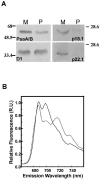Adaptation and acclimation of photosynthetic microorganisms to permanently cold environments
- PMID: 16524924
- PMCID: PMC1393254
- DOI: 10.1128/MMBR.70.1.222-252.2006
Adaptation and acclimation of photosynthetic microorganisms to permanently cold environments
Abstract
Persistently cold environments constitute one of our world's largest ecosystems, and microorganisms dominate the biomass and metabolic activity in these extreme environments. The stress of low temperatures on life is exacerbated in organisms that rely on photoautrophic production of organic carbon and energy sources. Phototrophic organisms must coordinate temperature-independent reactions of light absorption and photochemistry with temperature-dependent processes of electron transport and utilization of energy sources through growth and metabolism. Despite this conundrum, phototrophic microorganisms thrive in all cold ecosystems described and (together with chemoautrophs) provide the base of autotrophic production in low-temperature food webs. Psychrophilic (organisms with a requirement for low growth temperatures) and psychrotolerant (organisms tolerant of low growth temperatures) photoautotrophs rely on low-temperature acclimative and adaptive strategies that have been described for other low-temperature-adapted heterotrophic organisms, such as cold-active proteins and maintenance of membrane fluidity. In addition, photoautrophic organisms possess other strategies to balance the absorption of light and the transduction of light energy to stored chemical energy products (NADPH and ATP) with downstream consumption of photosynthetically derived energy products at low temperatures. Lastly, differential adaptive and acclimative mechanisms exist in phototrophic microorganisms residing in low-temperature environments that are exposed to constant low-light environments versus high-light- and high-UV-exposed phototrophic assemblages.
Figures















References
-
- Aizawa, K., and Y. Fujita. 1997. Regulation of synthesis of PSI in the cyanophytes Synechocystis PCC6714 and Plectonema boryanum during the acclimation of the photosystem stoichiometry to the light quality. Plant Cell Physiol. 38:319-326.
-
- Anderson, J. M. 1992. Cytochrome b6f complex: dynamic molecular organization, function and acclimation. Photosynth. Res. 34:341-357. - PubMed
Publication types
MeSH terms
LinkOut - more resources
Full Text Sources

